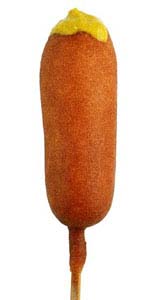Food on a stick
Food on a stick is created by impaling an item of food on an item of stick. An internationally celebrated form of cuisine, food on a stick is considered one of the four basic groups of food appealing only to people who are outdoors, sweaty, far from home and confused, or American. Food on a stick is also among the strongest supporting evidence for the famous scientific principle that "Everything is better on a stick."
History[edit | edit source]
Food on a stick is believed to be among the earliest examples of human tool use. Prior to this innovation, the use of fire to cook food was hampered by the fact that fire also cooks hands. After applying pointed sticks to already-dead, helpless pieces of meat, early humans had the idea of using larger, pointier sticks on the kind of meat that is still walking around and eating; food on a stick is thus linked directly to the invention of weaponryry and eventually warfare, as well as paving the way for more sophisticated forms of meat preparation which would in turn be put on more sophisticated sticks.
The Roman Empire and Other Political Units Led Largely by the Terminally Syphilitic[edit | edit source]
Throughout history, emperors, warlords and other psychotic maniacs of the type who end up ruling large empires have shown their fondness for impaling enemies and suspected enemies with such enthusiasm that it is almost inevitable for a few head of livestock to end up on the poles by accident. Through this process the carcass roasted on a spit has been independently discovered by each new generation of tyrant around the globe; to this day, the ability to watch a political enemy die slowly on a lance and calmly eat a kebab at the same time remains one of the most hotly-contested events in the annual Iron Dictator Games.
And China[edit | edit source]
As usual the Chinese came along and invented everything early. Some scholars maintain that the use of chopsticks -- which were common in the East long before early Europeans even developed opposable thumbs -- mean that nearly all Eastern foods qualify as food on a stick and are thus intrinsically superior. Other scholars reply that nobody ever claimed that everything is better between two sticks. Some scholars then pour gasoline on other scholars' flowerbeds, after which the debate tends to escalate.
The Wonders of the Modern Age[edit | edit source]
More recently -- current research indicates a date of 1189, but does not indicate why -- the invention of ice cream on a stick would introduce children around the world to the agony of food that will not remain entirely on a stick. Later innovations in industrial production would create mass distribution of entirely new forms, not only of food on a stick, but of foods suitable for putting on sticks, and of sticks suitable for putting food on.
Consumers of today wishing to make food on a stick for themselves can obtain everything from a high-tech electrical rotisserie grill to simple wooden toothpicks suitable for spearing olives and chunks of meat or cheese, or freezing into an ice-cube tray full of juice. In the near future, intoxicated experts agree, new innovations in food on a stick technology are sure to keep pace with other significant fields, and like most fields, will eventually involve lasers, robots, or laser robots.
Secrets of Success[edit | edit source]
Debate continues as to the central causes behind the massive success of food on a stick. Most experts agree that the following factors are involved, but long and dire and full grim with bloody fate have been the wars of academia over the relative importance of the contributing principles.
- Food on a stick satisfies two primal human needs at once, the need for nourishment and the need to play with sticks.
- Food on a stick can be eaten while walking, thus negating the metabolic impact of the exercise.
- Most types of food on a stick are of distinctly phallic shape, giving them an economic advantage as outlined by economist and voodoo priest Adam Smith in his 14th law of the free market, "Goods which resemble tits and cocks will always outsell goods which do not."
- Lollipops cure all nonterminal injuries.
- Food on a stick is the only form of food with which one can properly conduct an imaginary orchestra.

